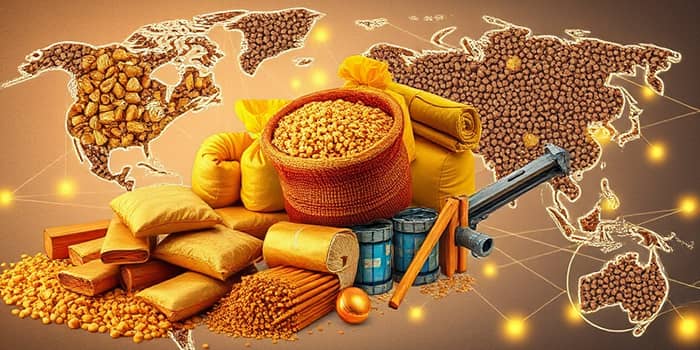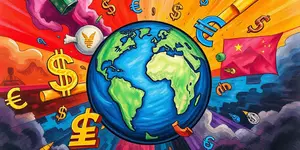
In 2025, stakeholders across industries are adjusting to a complex tapestry of global supply and demand. Commodity markets remain a vital barometer for economic health, reflecting inflation, trade flows, and innovation. This article unpacks the macro forces, sector-specific trends, financial indicators, and strategic imperatives shaping raw material dynamics today. By analyzing data, narratives, and emerging themes, we aim to equip readers with actionable insights to navigate an ever-evolving commodity landscape.
Population growth, urbanization, and economic expansion in emerging markets are fueling a sustained global demand trajectory for raw materials. Asia and Africa lead this surge, while developed nations continue heavy consumption due to infrastructure upkeep and high living standards. Central bank policies and inflation trends in the US and EU further impact pricing, with investors seeking commodities as a hedge against persistent inflation and uncertain trajectories.
Inflation in the US, with the Consumer Price Index at 2.9% and Core CPI at 3.2% as of December 2024, remains above long-term targets. Commodity indices outperformed both equities and bonds in 2022, underscoring their role in portfolio diversification. Meanwhile, fluctuations in the US dollar and interest rate expectations contribute to short-term volatility, demanding close monitoring by market participants.
Each commodity sector presents unique opportunities and challenges in 2025. Below is an overview of key trends, export capacities, and pricing drivers that define current market conditions.
Commodities are widely regarded as a protective instrument against inflationary pressures. The Bloomberg Commodity Index’s 16% gain in 2022 highlighted its capacity to outperform traditional asset classes during periods of rising prices. Central banks’ decisions on interest rates and quantitative easing have a direct bearing on commodity valuations, influencing both short-term trading and long-term investment strategies.
Key indices, such as the ISM New Orders Index at 52.5, offer insights into manufacturing demand, while the ISM Supplier Delivery Index and New York Fed’s Supply Availability Index reveal evolving supply chain conditions. A correlation of -0.95 between delivery times and supply availability underscores the predictive power of these metrics, guiding traders and procurement officers alike.
Raw material shortages that plagued manufacturers in 2021–2022 have eased but could re-emerge if new orders spike. Companies deploy advanced analytics and AI algorithms to forecast demand, optimize logistics, and buffer against disruptions. Supply chain visibility tools now cover every node, from mine to factory, enabling agile responses to unforeseen events.
Digital transformation is revolutionizing how raw materials are sourced, traded, and managed. The shift from paper-based Letters of Credit to blockchain-enabled smart contracts reduces transaction costs and settlement times. Companies harness machine learning predictive pricing models to predict price movements, identify arbitrage opportunities, and optimize inventory levels in real-time.
Sustainability imperatives, driven by regulatory pressure and consumer expectations, are accelerating circular economy initiatives. Exporters of recycled and bio-based materials are gaining a competitive edge, particularly in regions with stringent environmental standards such as the EU. Closed-loop models, which emphasize reuse and minimal waste, are emerging as both a compliance requirement and a commercial differentiator.
Geopolitical developments play a decisive role in commodity flows. Asia, Africa, and Latin America have become central to raw material production and consumption, driven by local demand and resource endowments. China’s increasing use of the renminbi for trade settlements reflects its growing influence in global markets, while its expanding copper blending capacity underscores strategic stockpiling.
Trade tensions, sanctions, and bilateral agreements can redirect supply lines overnight. For example, policy shifts in the US energy transition debate may alter fossil fuel demand forecasts, affecting global oil and gas prices. Similarly, infrastructure spending in India and Turkey shapes steel and scrap demand, with tariff safeguards influencing import flows.
Organizations seeking to thrive amid complexity must blend data-driven insights with adaptive frameworks. Below are key recommendations to enhance resilience and capitalize on emerging trends.
By combining strategic sourcing with digital tools and sustainability commitments, companies can mitigate volatility and position themselves for growth. Stakeholders who proactively adjust to geopolitical shifts, technological advances, and evolving consumer expectations will capture the greatest value from the raw material ecosystem.
In an era defined by rapid change, decoding the signals from raw materials offers a unique vantage point on global economic trends. Whether you are an investor seeking hedges, a procurement leader ensuring supply security, or a policymaker shaping industrial strategy, understanding these drivers is essential. The road ahead may be complex, but with the right insights and agile approaches, opportunities abound in the dynamic world of commodities.
References













